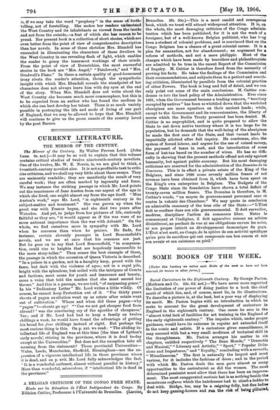SOME BOOKS OF THE WEEK.
[Under this heading we notice such _Books of the week as have not teen reserved for review in other forms.] Social Caricature in the Eighteenth Century. By George Paston. (Methuen and Co. 52s. 6d. net.)—We have never more regretted the limitation of our power of doing justice to a book the chief merit of which lies, and, of course, must lie, in its illustrations. To describe a picture is, at the best, but a poor way of displaying its merit. Mr. Paston begins with an introduction in which he seeks to account for the great development of caricature in England in the eighteenth century. One cause he sees in the "almost total lack of facilities for art training in the England of the early eighteenth century." The impulse which, under proper guidance, would have its outcome in regular art extended itself in the comic and satiric. If a caricature gives resemblances, it may succeed with but a very small modicum of technical skill in the draughtsman. Mr. Paston arranges his matter in six chapters, entitled respectively " The Beau Monde," "Dramatic and Musical," " Literary and Artistic," " Sport," " Popular Delu- sions and Impostures," and "Royalty," concluding with a seventh, " Miscellaneous." The first is naturally the largest and most various, for it includes the fashions of dress ; and in the period with which Mr. Paston deals the men gave almost as many opportunities to the caricaturist as did the women. The most determined pessimist must allow that there has been an improve- ment. The most exaggerated matinee hat is as nothing beside the monstrous coiffures which the hairdresser had to climbs ladder to deal with. Bridge, too, may be a reigning folly, but fine ladies do not keep gaming-horses and run the risk of being pilloried/ the predicament in which we see " Faro's Daughters." Athletics were met wholly neglected by the fair in those days,—it was in the nineteenth century that they fell into disuse. John Collet, in 1770, shows us "Miss Wicket" proud of having got forty-five "notches "—she is holding in her hand a cricket bat very like the hockey club of to-day—and "Miss Trigger" has a leash of pheasants in one hand and a fowling-piece in the other. She is trampling on a paper on which we can see the word " effeminacy." The volume is full of the entertaining and curious from cover to cover. We close it with the feeling—whether salutary or no we cannot pretend to decide—that on the whole we are not more foolish than our great-grandfathers.











































 Previous page
Previous page